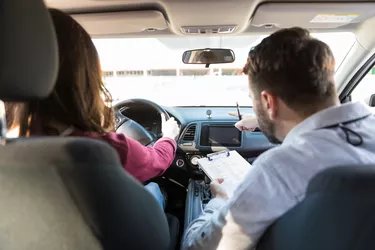
New drivers in Ohio don't have to pass a parallel parking test like they do in New York or Washington state, but they face another challenge: the maneuverability test. The maneuverability portion of Ohio's two-part, in-vehicle exam measures your ability to judge distances, control a car in tight spaces and perform common driving moves such as backing up, changing lanes and stopping. Honing a few skills at a maneuverability test practice site before taking the test should prepare you to pass.
Hone Your Technique
Video of the Day
Make the side mirrors your friends and hone your ability to use them to judge your car's position in relation to objects, curbs and other vehicles. Being in the habit of watching your mirrors lets you know when to turn the steering wheel during the maneuverability test, according to Heights Driving School.
Video of the Day
Consider also: What Is Learner Car Insurance?
Take Your Time
The maneuverability test is not timed. You want to proceed through the course as slowly as possible so you can avoid Ohio maneuverability test point deductions for errors.
Consider riding the brake if necessary to control your speed. Because the test checks how well you can navigate small spaces – such as a parking space in a garage or a drive-through lane – you want to move at the same steady yet slow pace you would use in those places. Try not to stop while being tested on this, though; you get a two-point deduction if you do.
Use a Familiar Car
You should take the test in a car you've driven before so you're used to its size, idle speed and steering. Vehicles differ, so you need to know how much and when to turn the steering wheel for your test car.
Turning the wheel enough to move the car where you want it to go is critical to passing the maneuverability test. If you turn the wheel too far or too little, you risk hitting one of the cones or coming to a stop with the car at an angle rather than parallel to the course. Avoid "dry steering," or turning the wheel when the car is stopped.
Consider also: Can a Minor Legally Purchase a Car?
Know the Maneuverability Cones Distance
The test starting point is a box formed with four cones, or markers, to resemble a parking spot. You'll want to be aware of the Ohio maneuverability test cone setup measurements which are nine feet by 20 feet.
A point cone sits 20 feet in front of this box, marking the center of the course. Your first action is to pull into the box and stop when your front bumper is even with the first set of cones.
The examiner will tell you when to begin and which side of the point cone he wants you to drive to. Turn to the left side of the point cone or the right as instructed, straighten the car after passing the point cone and stop parallel with the course. Then return to the box by backing through the course and coming to a stop in the center of the box in your original starting position. The test ends when you drive out of the testing area.
Think About Geometry
Navigating the maneuverability course may be easier if you think of your steering wheel as a circle. A half circle/full circle turning sequence can help you avoid the five points charged against you each time you touch a cone or marker.
As you leave the box and the examiner says to go left, watch your left-hand mirror. As soon as your car is even with the cone, turn the wheel 180 degrees to the left, or one half turn. Proceed forward, watching the right-side mirror. When it lines up with the cone on that side, turn the wheel one full turn – 360 degrees – to the right and then stop when the rear bumper is even with the point cone.
Don't turn the wheel when you put the transmission in reverse to return to the start position. Instead, back up slowly until you notice the right mirror is even with the point cone. Turn the steering wheel 360 degrees to the left. Finally, when your left mirror lines up with the next cone, turn 180 degrees to the right and then stop when your car reaches the same position from which you started.
Consider also: How to Renew a Temporary Driving Permit in Ohio